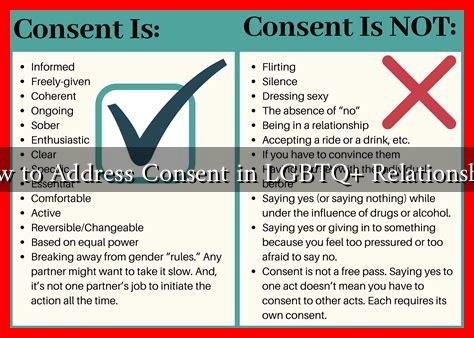-
Table of Contents
How to Address Consent in LGBTQ+ Relationships
Consent is a fundamental aspect of any relationship, but it takes on unique dimensions within LGBTQ+ communities. Understanding and navigating consent in these relationships is crucial for fostering healthy dynamics and ensuring that all parties feel respected and valued. This article explores the nuances of consent in LGBTQ+ relationships, offering insights, examples, and practical advice.
The Importance of Consent
Consent is not just a legal requirement; it is a vital component of mutual respect and understanding in any relationship. In LGBTQ+ relationships, where societal norms and expectations may differ from heterosexual relationships, the conversation around consent can be even more complex. Here are some reasons why consent is particularly important:
- Empowerment: Consent empowers individuals to express their desires and boundaries openly.
- Trust Building: Clear communication about consent fosters trust between partners.
- Prevention of Abuse: Understanding consent helps prevent coercive or abusive behaviors.
Understanding Consent in LGBTQ+ Contexts
In LGBTQ+ relationships, consent can be influenced by various factors, including cultural backgrounds, personal experiences, and societal pressures. Here are some key considerations:
- Intersectionality: Many LGBTQ+ individuals belong to multiple marginalized groups, which can affect their experiences with consent. For example, a queer person of color may face different societal pressures than a white gay man.
- Power Dynamics: Relationships may involve different power dynamics, especially in cases of age differences or varying levels of experience.
- Fluidity of Identity: The fluid nature of gender and sexual identities can complicate traditional notions of consent, requiring ongoing conversations about boundaries.
Effective Communication: The Key to Consent
Effective communication is essential for establishing and maintaining consent in any relationship. Here are some strategies to enhance communication around consent:
- Open Dialogue: Encourage open discussions about desires, boundaries, and comfort levels. This can be done through regular check-ins.
- Active Listening: Practice active listening to ensure that all partners feel heard and understood.
- Non-Verbal Cues: Be aware of non-verbal signals that may indicate discomfort or hesitation, and address them promptly.
Case Studies: Real-Life Examples
To illustrate the importance of consent in LGBTQ+ relationships, consider the following case studies:
- Case Study 1: A lesbian couple navigates consent by establishing a “yes means yes” policy, where both partners agree that any sexual activity requires enthusiastic consent. This approach fosters a safe space for exploration.
- Case Study 2: A transgender man and his partner discuss the impact of dysphoria on their intimate life. By openly communicating about triggers and comfort levels, they create a more supportive environment for intimacy.
Statistics on Consent and LGBTQ+ Relationships
Understanding the landscape of consent in LGBTQ+ relationships can be enhanced by examining relevant statistics:
- According to a 2020 study by the Human Rights Campaign, 46% of LGBTQ+ individuals reported experiencing sexual violence in their lifetime.
- A survey conducted by the National Center for Transgender Equality found that 47% of transgender individuals experienced sexual assault at some point in their lives.
These statistics highlight the urgent need for education and awareness around consent in LGBTQ+ relationships.
Resources for Further Learning
For those looking to deepen their understanding of consent in LGBTQ+ relationships, consider exploring the following resources:
Conclusion
Addressing consent in LGBTQ+ relationships is essential for fostering healthy, respectful, and fulfilling connections. By prioritizing open communication, understanding the unique challenges faced by LGBTQ+ individuals, and utilizing available resources, partners can create a safe environment where consent is not just a formality but a fundamental aspect of their relationship. As society continues to evolve, so too must our understanding of consent, ensuring that all voices are heard and respected.




